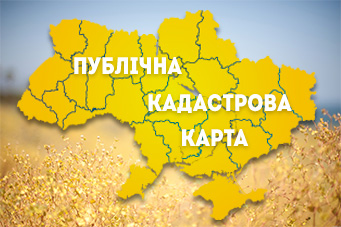Дізнайся більше: Держгеокадастр розпочинає інформаційну кампанію про відкриті можливості у земельній сфері
Держгеокадастр запрошує громадян до співпраці та активних дій
1 березня 2016 року Державна служба України з питань геодезії, картографії та кадастру розпочинає широку громадську інформаційну кампанію. Її мета – проінформувати суспільство про послуги та сервіси, які нещодавно з’явились у сфері земельних відносин, а також роз’яснити механізми захисту своїх прав. Проект реалізується за підтримки Європейського союзу у рамках Твіннінгу – інструменту політики сусідства для зміцнення стосунків з ЄС, поліпшення законодавчої та інституційної спроможності на основі кращих європейських практик.
Оскільки основні споживачі послуг Держгеокадастру знаходяться в сільській місцевості, фокус інформаційної кампанії зміщений на регіональний рівень. Тривалість проекту – один місяць, до квітня 2016 року.
За допомогою он-лайн мотиваторів та друкованих постерів Держгеокадастр зможе напряму звернутись як до громадян, так і до професіоналів земельного ринку, в лаконічній формі проінформувавши про різні аспекти земельних відносин. Зокрема, теми для промотування – електронні послуги, земельні аукціони, можливості запобігання отриманню неправомірної вигоди чиновниками. Канали комунікації – загальнонаціональні та регіональні групи в соціальних мережах, а також інформаційна підтримка в ЦНАПах та в територіальних управліннях Держгеокадастру.
Основний інформаційний трафік припадатиме на регіональні пабліки у найпопулярніших соціальних мережах. Планується, що через digital-канали буде охоплено близько 2,8 мільйона користувачів соціальних мереж, а також сотні тисяч відвідувачів Центрів надання адміністративних послуг та терорганів Держгеокадастру.
У Держгеокадастрі впевнені, що за підсумками проекту громадяни, що долучились до нього, значно підвищать рівень обізнаності про свої права у земельній сфері та активніше користуватимуться сучасним функціоналом Державного земельного кадастру, який постійно розширюється та удосконалюється.
 [:en]This is our small homeland,
[:en]This is our small homeland,
Clear nadbuzhstska land.
Cherry; prosperous, welcoming.
What lures them away.
Glorious and garden and field.
Hands in hard callouses.
This is where our roots i.dolya,
And the house in clear towels.
And the bread on the table in the parlor,
On a visit. As you look,
And Vinnytsia our capital,
Podolsky edge star
Vinnitsa region – the land of green oak and golden cornfields. Nature here is charming, rich history of heroic events, the economy developed. Anyone who has ever visited the Vinnytsia forever remember the clear rivers and blooming orchards, vast steppes and friendly vinnichan. It is not surprising that along with the word “Vinnichchina” often are such clear comparison as the “flower garden”, “sugar Donbas”, “Podolsky Switzerland” … All together for AL obraznymvyrazom Ukrainian, that is the beauty of Ukraine -Podillya. Today Vinnichchina celebrates its 75th anniversary. The region formed on 27 February 1932’roku.- occupies an area of 26.5 sq.km. ie. 4.4% of the country. Located in the steppe zone of Right Bank Ukraine. It borders on the Zhytomyr ,. Chernovtsy, Khmelnitsky, Cherkasy, Kirovohrad and Odesa regions and in the south -with the Republic of Moldova.
Vinnytsia region extends north to 49 ° 53 ‘hin. w. (Start small river near the village Nastia Kashperivky Koziatyn district) in the south was limited. Dniester (south of the village. A large area Kisnytsya Yampilsisoho -48 ° 04’pn. W.). The extreme western point of the region: znahodytsya.- in Murovano-Kurylovetskomu area (confluence p. Materky.v Dniester reservoir – 27 ° 35’sh. D.). The extreme eastern point is Bershad region east of the village Ternovka (30 ° 02 ‘east. D.).
The geographical center of the region is in the area between the villages Nemyriv Nykyforivtsi and Luke.
The area is conveniently located relatively large industrial cities of Ukraine. Thus, the distance from the winery to Kyiv -256 km -434 km Odessa, Lviv -365 km .;
The geographical position in the center of Ukraine stipulates tranzytnist territory – the region is crossed by international railway and highways, stretching from north to south (Kyiv – Odesa) and from east to west (Kharkiv, Lviv), are export pipelines, power lines.
Population oblasti.- 1720.1 thousand. People (1.01.2005.).
Today, within the region there are 27 administrative districts, there are 18 cities, including 6 cities of regional subordination: Vinnitsa, Mogilev-Podilskny ,. Zhmerynka, Koziatyn, Khmilnyk, Ladyzhin; 29se, lmsch urban type and 1466 villages.
Executive power
Regional State Administration
District state administrations 27
Local governments
Regional Council. Deputies – 96;
District councils – 27 deputies – 1303;
City (cities of regional importance) councils -in, deputies – 208;
City (cities of regional significance) councils – 12 deputies -381;
Village Councils – 28 deputies -726;
Village councils – 661, deputies – 10440;
District councils in the city. Vinnitsa – 3, deputies – 97.
Preceded by the formation of a long history, full of struggle and events, wars and feats.
In the 12th century the northern part of the modern, Vinnitsa region was part of the so-called Bolohivskoyi land. IV mid-13th century warlike horde Tatar-Mongol invaders captured .mayzhe all East Slavic lands, including Pobuzhya. At that time, first appears the name “skirts”. After the Battle of Blue Waters (1362) skirts part of the Grand Duchy of Lithuania as a separate administrative unit – Podolsky land.
Vinnitsa origin of the name is not completely understood. Some historians believe the name-from scho.vona Vinnychky stream, a tributary of the Southern Bug. Others – say the name of tsya.pohodyt distilleries, wine cellars, which were .tut in antiquity. Ale.bilshist researchers believe that this name originates from the old word “vno” – dowry, dowry. Indeed, the Grand Duke of Lithuania Algirdas capturing territory skirts, was generously handing out land lords. Vinnitsa got brothers Koriatovich – nephews Olgerd. In Vinnitsa chronicles first mentioned as a fortress in 1363.
In 1434 was created Podolsk province as part of the Polish Kingdom. His pivdyenno eastern border with the Grand Duchy of Lithuania was passed on. Murafa. XV. Skirts was part of Kievan principality and the first half of the XVI century. – To Volyn. Only in 1566 was created Bratslav province of three counties – Bratslav, Vinnitsa and Zvenigorod. In 1569 Bratslav province passed .To Poland.
In the eighties XVI century on the island Kempa built another castle. The city is built at this time increases. The buildings on the right bank were called New Town and the Old Fortress and the surrounding area is still called Old Town.
In the years 1672-1699 Bratslavshchina part of the n principalities. Resolution of the Seimas Things Poslolytoyi on November 2, 1791 approved the new administrative division of Bratslav province for 4 districts: Vinnytsia. Bratslav, Nadbuzkyy (centered in the city. Grand) and Zvenigorod. However, this division has not been implemented.
In the second half of XVI – first half of XVII century has economic growth of cities Shargorod, Mogilev, Litin, Tulchin and others. 30-40 years XVII century was a period of economic and cultural development. In 1640 Vinnitsa won the right to have its own seal and emblem. The emblem of the city depicted two swords and two fishing rods.
And part of Lithuania, and later the Commonwealth Vinnytsia fortress walls witnessed many fierce battles. Whip around Ladyzhin, Zhvanets on the Dniester, Bush nearby Yampol were not only witnesses, but also participants of the heroic epic, when battlefields Storico blood flowed into the Black Sea.
Many significant events .viyny Ukrainian liberation, people closely related to the Vinnitsa. Under the leadership of the national commander Maxim Krivonos in July 1648 rebels vyzvolyly.Vinnytsyu of Polish troops.
Liberation War will not bring desired skirts. It tomylosya then under Polish oppression, .to under Turkish, then again nearly a hundred tolerated power of the Polish gentry. Yet the spirit of insubordination .and no freedom left Podolyan. In folk memory, thoughts and songs to this day the names of famous people live edge -Ustyma Karmelyuka Maxim. Krivonosa, Severyna Nalyvaiko, Daniel Nechay; Ivan Bohun, Ivan Sirko and many others. In the winery pobuvav- Bogdan Khmelnitsky. Hetman stayed here for the first time in November 1649, when he returned from the Zborov and again – in December 1654, leaving the council to Pereyaslav. In Pereiaslav Council 8 January 1654 Ukraine was annexed to Moscow within the limits of signification Zborowski contract. Only after 1793, when the Right-Bank Ukraine was annexed to Russia, Vinnitsa became the center of Bratslav province. In 1796 the “former Podolsk Ukraine – Volyn and Podillya” was formed two provinces – Volyn and Podolsk, and separated the territory for the Kyiv province.
In 1801 the frontier province was divided into two military governorship: 1) Kiev from Minsk; 2) Volyn Podolsky.
After the reform of 1861 in Tsarist Russia entered the administrative-territorial division of the parish. In 1863 in Podolsk province there were 376 counties. The division into townships existed until 1923, when it was formed areas.
Significant development of the city contributed to the construction in 1871 of the railway line Kyiv-Odessa-Balta that laid through Koziatyn, Vinnitsa, Zhmerynka.
In 1880 construction ends iron – foundry plant “Hammer”. Began working seed and superphosphate factories, shoe factory “Hawk.” Developing trade. In 1881, the bank opened Vinnytsia City.
A major event for the winery was the opening of cultural institutions: National House (1902) and City Theatre (1910). In 1911, the street ends at the Postal building City Council. And in 1912 completed the construction of one of the buildings naporyhinalnishyh our city – the hotel “Savoy” – now “Ukraine”. It was equipped with central water heating and electric lift, which at that time was rare.
In 1912, from the center to Zamosc laid tram connections. She began working telephone exchange. It zakladeno.miskyy park.
Vinnytsya hurricanes swept over the revolution and devastating wars. Many remember the uprisings and strikes towns and villages skirts.
History was destined to the rather complex Vinnitsa responsible stage of the Ukrainian revolution 1917 – 1921 .rokiv three became the seat of government of the Ukrainian People’s Republic. For the first time in December 1918, during the anti Hetman rebellion, led by the Directorate. The second time – in February-March 1919, after the retreat of Kyiv, and the last time – in May 1920, after the Warsaw Pact on the basis of Polish army launched a campaign in Ukraine.
Center Podolsk province moves from the city. Kamyanets-Podolsky Vinnytsia and stay here until the liquidation of the province in 1925.
In 1923, the beginning of Soviet administrative-territorial reform on the tail. Liquidated counties become larger areas formed part.
According to the resolution IV Extraordinary Session of the CEC VU XII convocation on February 9, 1932 in Ukraine created 5 areas: Kharkiv, Kyiv, Vinnytsia, Dnipropetrovsk and Odessa. Vinnytsia region formed February 27, 1932 corresponding decree, the same session. It has brought parts of modern Khmelnitsky, Vinnitsa and Zhitomir regions of. The region included 73 administrative units: 2 cities (Vinnitsa and Berdichev) and 71 district.
It was a difficult historical period. Years of forced collectivization that brought not only progress but also the terrible famine of 1932-33., Mass repressions. Significant achievements that won Vinnytsia region for prewar five suffered cost the lives of many of our countrymen.
In the prewar years Vinnichchine created new industries, there were 504 industrial enterprises; reconstructed 20 sugar factories. A movement buryakivnyts-pyatysotynnyts Taisiya Weaver, Odarka Tymoschenko, Lyudmila Hnatiuk, Palazhky Slobodyanyuk and many others.
In 1940-41rr. In 1540 school enrollment area 366.7 thousand. children worked in 1268 libraries, 1562 clubs. Was eliminated illiteracy. In 1933 it was reorganized Vinnytsia Pedagogical Institute, which studied the great Ukrainian writer Mikhail Stelmakh, Alexander Levada, literary critic and translator Yuri Nazarenko. In 1934 in Vinnitsa Medical Institute opened.
In July 1941 year Vinnitsa region occupied by German fascist invaders. Over 970 days of occupation shot and tortured more than 200 thousand. Vinnichan, almost 46 thousand. Soldiers, 64 thousand. Citizens deported to hard labor. Vinnichane courageously fought against the Nazi occupiers. 128 Podolyan for exploits in the Great Patriotic War were awarded the title Hero of the Soviet Union. These underground organizer of Vinnitsa Ivan Bevz, coherent clandestine center Lala Town Hall and General of the Army and Colonel I.D.Chernyahovskyy I.N.Boyko awarded this title twice. National hero became a member of the French resistance movement, born Vasily Khmelnitskiy area Porika, and Nicholas Buyanov of Mogilev Podilschyny became a national hero in Italy.
From the first days after liberation, was opened in the early start-up work for companies, in rebuilding the economy, schools, hospitals and railways. And a year later were commissioned 316 industrial plants, 3 institutes, 7 colleges, 1,476 schools, 109 hospitals. In 1944, reopened in 1965 farms, 38 farms, 84 MTS. Life was taking its toll, cilia and its consequences would rather forget liquidate. Although the numbers were a lot of progress distress and grief. Crop failure in 1946 and the authorities in relation to the peasants again led to famine, when people are dying as the hungry thirties. In 1948, almost all enterprises were revived, constructed new – tool factory, oliyezhyrkombimat, plant structures and others.
During the period from 1951 to 1990, a faster pace of developing engineering, power, chemical industry, construction materials. Industrial production increased more than 13 times, and productivity 6 times. Constructed and renovated dozens of industrial enterprises. Great attention was paid to the construction of housing, community facilities. In the postwar years commissioned 27 million sq. M. meters of living space, including 17m. In rural areas. Gone profound changes with agriculture. The use of mechanization, scientific achievements have contributed to the continuous growth of agricultural production.
Many places Vinnitsa region associated with the names of famous people. Podolsky This land is the birthplace of the writer Kotsiubynskyi Ukrainian and Russian poet Nikolai Nekrasov, the first president of the Ukrainian state, the famous historian Michael Hrushevsky, and the first president of the Academy of Sciences of Ukraine, a prominent microbiologist Daniel Zabolotny, Ukrainian magicians Stepan Rudanskogo humor and Oleg stork, Patriarch Vladimir Kobzar Art Perepelyuka Heroes of Sevastopol defense and sailor Peter Cat, founder of Ukrainian classical choral singing Mykola Leontovich and Yaroslav Ivashkevich Polish writer, poet Vasyl Stus and many others.
Here lived and rests prominent surgeon Nikolai Pirogov. Worked known Ukrainian artist Ivan Soshenko. He did the first test of flying machines Mozhajskij Alexander. In the city. Tulchin created his famous work – “Science of Victory” world famous commander Alexander Suvorov. Here, under the guidance of the Decembrist Pestel was created by Southern Company, lived IM Kotlyarevsky, pryyizdzhav Pushkin. In Nemirove gave one of his last concerts of Ferenc Liszt, here came Honore de Balzac. In Brayilov lived and worked PI Tchaikovsky. The village Kukavka wrote his paintings VA Tropinin. For decades led the economy in the countryside TymanHvka twice Hero of Socialist Labor Philip Zhelyuk.
On the threshold of the millennium Vinnichchina came from diversified industrial complex, leading to which is the food industry, power engineering, machine building, metalworking, production of construction materials. In the production of grain and sugar beet Vinnitsa region ranks first among the regions of Ukraine.
Help change the administrative-territorial division Vinnytsya region
According to the resolution IV Extraordinary Session of the CEC VU XII convocation on February 9, 1932 in Ukraine created 5 areas: Kharkov, Kiev, Vinnitsa, Dnepropetrovsk and Odessa. The structure Vinnytsia region, which is formed directly on zasidanni.orhanizatsiynoho Committee to create a region 27.02.1932 p. 71 became administrative unit: 2 cities (Vinnitsa and Berdichev) and 69 districts: Antonov, Babanskii, Bar, Bershad, Bratslav, Volochisskiy , Voronovytskyy, Gaysinskiy, Gorodetsky, Hrytsivskyy, Derazhniansky, Dzhulynskyy, them. Dzerzhinsky (Romanov) Dunaeveczkij, Zhmerinskiy, Zaslavsky, Zatons’kyj (Vinkovetsky) Illintsi, Kalinowski, Kozyatyn, Kam’yanyetskyy, Kopayhorodskyy, Kryzhopolsky, Lipovetsky, Litinskiy, Lubarsky Letkchivskyy, Lyahovetskyy, Monastyrischensky, Mahnivskyy, Medzhybizh, Myhalpilskyy, Mogilev, Murovanokurylovedkyy, Nemirovsky, Novoushitskiy, Oratovsky, Orynynskyy, Pischans’kyy, Plyskivskyy, Pogrebysche, Polonsky, Proskurivska Salavat, Smotrytsky Solobkivetskyy, Stanislavchytskyy, Starokrstyantynivskyy, Staroushytskyy, Teofipilskyy, Teplice, Tyvrovsky, Tomashpil, Triostyanetskyy, Tulchinsky, Ulanivskyy, Uman, Khmelnitsky, Khrystynivka, Chemerovets’kyi, Chernivtsi, Chechelnitsky, Chudnovsky, Shargorodskii, Shepstivskyy, Yurynetskyy, Yampolsky, Yanushpilskyy, Yarmolinetskiy.
In May 1935 within the Vinnitsa region was formed four border districts: Kamenets composed of 9 districts, Mogilev-Podolsky – be areas Proskurivska – 9 rayoniv.i Shepetovsky 10 areas!
In 1937 with the formation of Kamenetz-Podolsk and Zhitomir, areas ceded to them much of the districts of Vinnytsia region; Border districts were eliminated. As part of the Vinnytsia region remained two city council of regional subordination (Vinnytsia and, Mogilev-Podolsky) and 42 districts: Bar, Bershad, Bratslav, Vinnytsia, Voronovytskyy, Gaysinskiy, Dashivsvkyy, Dzhulynskyy, Zhmerinskiy, Illintsi, Kalinowski, Kozyatyn, Komsomolsk (former Mahnivskyy) , Kopayhorodskyy, Kryzhopolsky, Lipovetsky, Litinskiy, Monastyrischensky, Murovanokurilovetskiy, Nemirovsky, Obodivskyy, Olhopilskyy, Oratovsky, Peschansky, Plyskivskyy, Pogrebysche, Sytkovetskyy, Stanislavchytskyy, Teplice, Tyvrovsky, Tomashpil, Trostyanetsky, Tulchinsky, Turbov, Ulanivskyy, Khmelnitsky, Chernivtsi, • Chechelnitsky, Shargorodskii, Shpykivskyy, Yampolsky, Yaryshivskyy.









